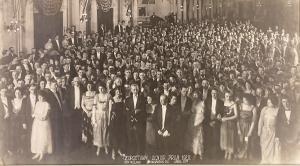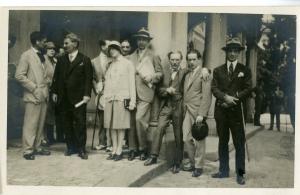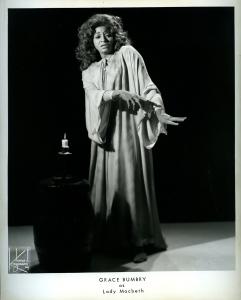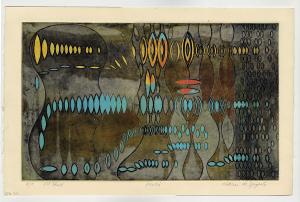This exhibition reveals the interrelated musical holdings in the Booth Family Center for Special Collections across all curatorial units including the University Archives, the Art Collection. Rare Books, Manuscripts and the Woodstock Theological Library. In so doing it presents a rare opportunity for viewers to see these items displayed together in imaginative pairings and groupings. Musical Synergies Across Collections celebrates the richness of the Library’s non-circulating special collections and why they are such a valuable resource for students, faculty and researchers. In keeping with the Robbin Gallery's mission to display objects relating to music, these pieces range from 19th-century student musical groups on campus to a photograph of Black jazz musicians from New Orleans, a colorful jazz-themed artwork by Romare Bearden, and an album of Black composers works by William Grant Still and Samuel Coleridge-Taylor.
The Robbin Gallery is open for in-person viewing weekdays from 10:00 to 4:00 and by appointment. We welcome inquiries and feedback at speccoll@georgetown.edu
The Enraged Musician
William Hogarth
(British (English), 1697 – 1764)
11/1741
Engraving on paper
Gift of Lydia Freeman, 1993
1993.9.21
William Hogarth, the satirist of 18th century British society, is known for his moralizing narrative series such as A Harlot’s Progress (1732), A Rake’s Progress (1735), and Marriage à la Mode (1745). The Enraged Musician was conceived as a companion piece to his print entitled The Distressed Poet, both engraved from Hogarth’s original paintings. Conveying the din of London street life, the artist populated his scene with various noise-making characters and creatures whose combined efforts have distracted a musician at an open window from his practice. The composition pivots around the central figure of a graceful milkmaid, her mouth open in song. In his three-volume biography of Hogarth, Ronald Paulson proposes the theme of nature versus art in contrasting the purity of the milkmaid with the affectations of the foreign violinist: “Her beauty and grace are surely intended to suggest that her voice, which among the sounds of nature is art, is more beautiful than the musician’s violin because less constricted by conventions.”
College Cadet Band cymbals
date unknown
Items from Carroll Parlor Collection
GTA-150908
The Georgetown College Cadets were first organized in 1832. Between 1852 and 1860 at least 175 students served in two companies taking part in bayonet drills, target practice, and marching exercises. The Cadets represented the University at public events and served as escorts for distinguished visitors to D.C.
Songs, Sketch of the Life ... of Blind Tom the Marvelous Musical Prodigy, the Negro Boy Pianist
New York: French & Wheat, circa 1868
Leon Robbin Fund purchase
GTM-20230425
Thomas "Blind Tom" Wiggins (1849-1908) was one of most widely known American pianists of the 19th century. Born into slavery, Tom was a musical prodigy and he reportedly composed his first song at the age of five. By age eight he was touring the United States extensively and in 1860 he performed for President James Buchanan at the White House. The money that he earned throughout his career went to the family of his enslaver, and later manager, General James Neil Bethune.
Georgetown College Mandolin Club
1896-1897
University Archives Photographic Collection
GTA-000109
The 1890s saw the growth of numerous student musical groups on campus, among the most popular of which were the Mandolin and Banjo Clubs.
Concert by the Anthracite Glee Club of Scranton, PA, and the Georgetown University Banjo and Mandolin Clubs
March 5, 1897
Old Archives: Music, Box 1
GTA-000275
The Anthracite Glee Club of Scranton, Pennsylvania, traveled to D.C. in 1897 to take part in celebrations for the first inauguration of President William McKinley on March 4.
Selection of dance cards
ca. 1910-1936
Dance Card Collection
GTA-000562
Dance cards listed the order of music to be played by an orchestra or band during a dance. Originating in the 18th century, they came into common use in nineteenth- century Vienna. Usually carried by women, the cards had pencils attached so gentlemen could write their names next to dances they wanted to reserve. Some dance cards even had comment sections.
Georgetown Senior Prom
April 15, 1920
University Archives Photographic Collection (Oversize)
This Prom, held at the New Willard Hotel on Pennsylvania Avenue, was open to the entire student body. Music was provided by the Meyer Davis Orchestra.
Z Pražského Ghetta. Písně. (From the Prague Ghetto. Songs.)
Vašata, Rudolf Leo (composer)
(Czech, 1888 – 1953)
Wierer, Alois (illustrator)
(Czech, 1878 – 1945)
1913
Lithograph
Publisher: Mojmir Urbánek, Prague
Leon Robbin Fund purchase
GTM-20210426
The cover illustration depicts the late-sixteenth-century Rabbi of Prague Judah Loew ben Bezalel. He is perhaps best known for his role in Jewish folklore as the creator of the golem, a creature fashioned from clay to protect the Jewish community from anti-Semitic attacks. Here Loew serves as an icon of Prague’s Jewish community and the cultural legacy of its Ghetto.
Symphony for Chamber Orchestra and Alto Voice, 2nd movement: “Marche”
Krása, Hans
(Czech, 1899 – 1944)
November 1922
Autograph music manuscript
Première: April 24, 1923, Paris, Théâtre des Champs-Élysées
Leon Robbin Fund purchase
GTM-20100416
Hans Krasa, a Jewish Czech composer murdered at Auschwitz, is another representative of Prague’s musical legacy. He composed the symphony displayed here when he was just 22 years old. The marks in blue and red pencil, a common feature of music manuscripts, show corrections and additions to the score, likely made by Krasa himself.
Picture Postcard of Hans Krasa with Colleagues
Photographer unknown
1922 – 1933
Photographic postcard
Robbin Fund purchase
GTM-20100416
Krasa is standing second from the right; the man with his arm on Krasa’s shoulders, Walther Straram, was a conductor and concert organizer who played an important role in advancing Krasa’s career. The cellist Filip Lazar is to Krasa’s left, and the tall man in the middle of the group is the composer and pianist Alfredo Casella.
Concert series announcement for the “Quatre Concerts de Musique Moderne Internationale”
Straram, Walther (conductor and promoter)
(English, 1876 – 1933)
Krása, Hans (composer)
(Czech, 1899 – 1944)
1923
Pamphlet
6 pages (one oblong leaf folded twice)
Leon Robbin Fund purchase
GTM-20100416
This program includes the April 1923 première of Krasa’s symphony. It indicates how talented he was: at only 24 years old, he shares billing here with a “who’s who” of 20th-century art (i.e., “classical”) music. Had his life not been cut short by the Holocaust, Krása’s works would likely be as familiar as the others listed in this program.
Song of the Polish underground = Pieśń polski podziemnej
Eiger, Walter
New York City : Harmonia Distributing and Publishing Co.1944
Rare Books Collection
M1755.6 .E36 1944
Were you there when they crucified my Lord : a Negro spiritual in illustrations
Crite, Allan Rohan
Cambridge, Massachusetts : Harvard University Press, 1944
Rare Books Collection
N8053 .C7 1944
In this illustrated devotional, African American artist Allan Crite (1910–2007) depicts the verses of the African American spiritual Were You There When They Crucified My Lord. Crite created thirty-nine full-page illustrations showing Biblical scenes of Christ’s passion, death, resurrection, and ascension.
Roland Hayes signed portrait photograph
Photographer unknown
Circa 1940s, signed in 1960
Black-and-white photographic print
Leon Robbin Fund purchase
GTM-20230426
Roland Hayes (1887-1977) was an American tenor and composer. As a singer Hayes toured Europe extensively starting in the 1920s, including a command performance at Buckingham Palace at the request of King George V and Queen Mary. He was also the first Black American soloist to perform with the Boston Symphony Orchestra in 1923.
Leadbelly Playing Guitar [Huddie Ledbetter]
Gordon H. Coster
(Holland, 1903-1906 – 1988)
20th century
Gelatin silver print [facsimile]
Gift of Jeffrey Perry, 2010
2010.3.22
Huddie Ledbetter, known as Lead Belly (or Leadbelly)
(1888/89 – 1949), was born near Shreveport, Louisiana, and displayed a natural talent for music from a young age. He went on to become a famous singer-songwriter in multiple genres including gospel, blues and folk music with an extensive list of recordings. Although Lead Belly played several instruments, he favored the 12-string guitar and often sang while stomping his feet or clapping to the rhythm. He was inducted into the Rock and Roll Hall of Fame in 1988 and the Louisiana Music Hall of Fame twenty years later.
“Hoya Staff Member Queries The Beatles”
Michael M. Egan, III
The Hoya,
February 20, 1964
The Hoya has a long tradition of entertainment coverage and reviews. A high point in the paper’s entertainment reporting came with this interview of The Beatles who were in Washington, D.C., for their first live concert appearance in the U.S.
The Shirelles in McDonough Gym
1964
University Archives Poster Collection, Box 6
GTA-000120
Gift of Tim Largay, Class of 1965
This concert was part of the Fall Festival sponsored by the College Student Government. The Shirelles were an American girl group formed in 1957 by schoolmates in New Jersey. The song Will You Still Love Me Tomorrow, highlighted on the poster, was released in 1960 and went to number one on the Billboard charts.
Jazz Funeral, New Orleans
Leonard Freed
(American, 1929 – 2006)
1965
Gelatin silver print [facsimile]
Gift of Jeffrey Perry, 2017
2017.19.15
Leonard Freed was an influential documentary photographer and member of the international cooperative known as Magnum Photos, founded in Paris in 1947. In the 1960s, Freed traveled in the entourage with Martin Luther King, Jr. during his famous cross-country progress from Alabama to Washington. This image was taken at a jazz funeral in New Orleans during that period. A slightly different shot from the same event was published in Freed’s 1968 book Black in White America.
Photograph of Grace Bumbry performing as Lady Macbeth
James J. Kriegsmann
(American, 1909 – 1994)
Circa 1967
Black-and-white photographic print
Leon Robbin Fund purchase
GTM-20170627
Grace Bumbry (1933-2023) was a pioneering mezzo-soprano opera singer whose long career spanned decades. A critically acclaimed vocalist, she received a Grammy Award in 1972 for Best Opera Recording, was recognized as a member of the Commandeur des Arts et Lettres from the French government, and was a recipient of the Kennedy Center Honors in 2009.
Photographic portrait of Samuel Coleridge-Taylor
Elliott & Fry, London
circa 1895
Cabinet card photograph
Leon Robbin Fund purchase
GTM-20240306
Samuel Coleridge-Taylor (1875-1912) was a Sierra Leonean-English composer who is most well known for his three cantatas on the 1855 poem The Song of Hiawatha by Henry Wadsworth Longfellow. Published between 1898 and 1900, the trilogy was among the most popular musical works of the time and made Coleridge-Taylor famous in both Europe and the United States.
Photograph of William Grant Still
Photographer unknown
circa 1960s
Black-and-white photographic print
Mickey Thomas Terry Papers
GTM-20230707
William Grant Still (1895-1978) is known as the “Dean of Afro-American Composers.” His most famous work, Afro-American Symphony (1930), was tremendously popular and was the first symphony composed by an Black American to be performed by a major orchestra.
Black Composers Series Vol. 2
William Grant Still/Samuel Coleridge-Taylor
New York: Columbia Masterworks, 1974
Hildred Roach Collection on Pan African Composers
GTM-20230714
Jamming at the Savoy
Romare Howard Bearden
(American, 1911 – 1988)
1981
Etching and aquatint on paper
Art Collection purchase, 1989
1989.3.1
Romare Bearden grew up in New York City and lived among the influential figures of the Harlem Renaissance, some of whom were regular visitors at his childhood home. His father was a pianist and his mother presided over the Colored Women's Democratic League. During the Civil Rights era Bearden began working in collage and compared the process of cutting images out of publications and assembling them on paper to the improvisational nature of jazz music. Bearden also wrote poetry and music. He co-authored the hit song Seabreeze (1950) that was recorded by performers such as Billy Eckstine and Dizzie Gillespie. This photo etching was produced for the exhibition Romare Bearden 1970-1980 held at the Brooklyn Museum.
Music
Kathleen Spagnolo
(American, 1919 – 2016)
20th century
Etching with multi-level viscosity printing on paper
AP
Gift of the Estate of Kathleen Spagnolo
2016.15.4
Spagnolo’s abstract representation of sound incorporates waveforms, spectrograms, and even (on the far right) what looks like a bumps on a music box cylinder.
Curators: Lynn Conway, Kevin Delinger, Christen Runge, Jay Sylvestre, Adrian Vaagenes, LuLen Walker and John Zarrillo
Exhibition Web Page: Emily Jeong (SFS '2025)













![Leadbelly Playing Guitar [Huddie Ledbetter]](/sites/default/files/styles/exhibition_thumbnail/public/2024-12/2010.3.22.jpg?itok=VUQkTLH8)








